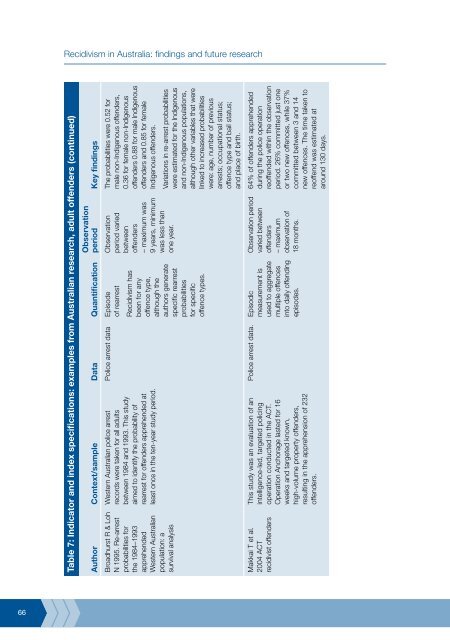Recidivism in Australia : findings and future research - Australian ...
Recidivism in Australia : findings and future research - Australian ...
Recidivism in Australia : findings and future research - Australian ...
Create successful ePaper yourself
Turn your PDF publications into a flip-book with our unique Google optimized e-Paper software.
66<br />
<strong>Recidivism</strong> <strong>in</strong> <strong>Australia</strong>: f<strong>in</strong>d<strong>in</strong>gs <strong>and</strong> <strong>future</strong> <strong>research</strong><br />
(cont<strong>in</strong>ued)<br />
Table 7: Indicator <strong>and</strong> <strong>in</strong>dex specifications: examples from <strong>Australia</strong>n <strong>research</strong>, adult offenders<br />
Observation<br />
period Key f<strong>in</strong>d<strong>in</strong>gs<br />
Author Context/sample Data Quantification<br />
The probabilities were 0.52 for<br />
male non-Indigenous offenders,<br />
0.36 for female non-Indigenous<br />
offenders 0.88 for male Indigenous<br />
offenders <strong>and</strong> 0.85 for female<br />
Indigenous offenders.<br />
Observation<br />
period varied<br />
between<br />
offenders<br />
– maximum was<br />
9 years, m<strong>in</strong>imum<br />
was less than<br />
one year.<br />
Police arrest data Episode<br />
of rearrest<br />
<strong>Recidivism</strong> has<br />
been for any<br />
offence type,<br />
although the<br />
authors generate<br />
specific rearrest<br />
probabilities<br />
for specific<br />
offence types.<br />
Western <strong>Australia</strong>n police arrest<br />
records were taken for all adults<br />
between 1984 <strong>and</strong> 1993. This study<br />
aimed to identify the probability of<br />
rearrest for offenders apprehended at<br />
least once <strong>in</strong> the ten-year study period.<br />
Broadhurst R & Loh<br />
N 1995. Re-arrest<br />
probabilities for<br />
the 1984–1993<br />
apprehended<br />
Western <strong>Australia</strong>n<br />
population: a<br />
survival analysis<br />
Variations <strong>in</strong> re-arrest probabilities<br />
were estimated for the Indigenous<br />
<strong>and</strong> non-Indigenous populations,<br />
although other variables that were<br />
l<strong>in</strong>ked to <strong>in</strong>creased probabilities<br />
were: age, number of previous<br />
arrests; occupational status;<br />
offence type <strong>and</strong> bail status;<br />
<strong>and</strong> place of birth.<br />
64% of offenders apprehended<br />
dur<strong>in</strong>g the police operation<br />
reoffended with<strong>in</strong> the observation<br />
period. 26% committed just one<br />
or two new offences, while 37%<br />
committed between 3 <strong>and</strong> 14<br />
new offences. The time taken to<br />
reoffend was estimated at<br />
around 130 days.<br />
Observation period<br />
varied between<br />
offenders<br />
– maximum<br />
observation of<br />
18 months.<br />
Police arrest data. Episodic<br />
measurement is<br />
used to aggregate<br />
multiple offences<br />
<strong>in</strong>to daily offend<strong>in</strong>g<br />
episodes.<br />
This study was an evaluation of an<br />
<strong>in</strong>telligence-led, targeted polic<strong>in</strong>g<br />
operation conducted <strong>in</strong> the ACT.<br />
Operation Anchorage lasted for 16<br />
weeks <strong>and</strong> targeted known,<br />
high-volume property offenders,<br />
result<strong>in</strong>g <strong>in</strong> the apprehension of 232<br />
offenders.<br />
Makkai T et al.<br />
2004 ACT<br />
recidivist offenders















